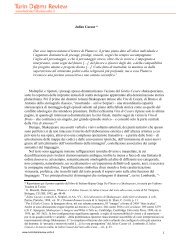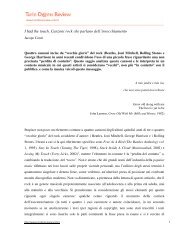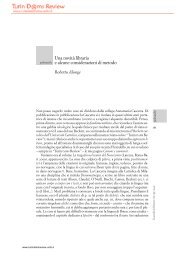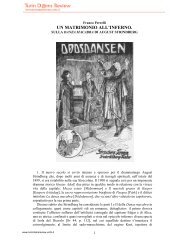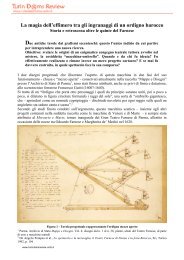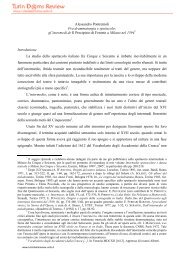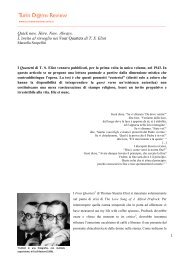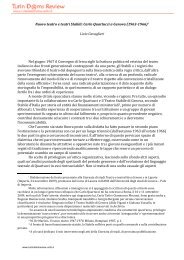Antigone di Sofocle di Brecht: un modello possibile di resistenza di ...
Antigone di Sofocle di Brecht: un modello possibile di resistenza di ...
Antigone di Sofocle di Brecht: un modello possibile di resistenza di ...
Create successful ePaper yourself
Turn your PDF publications into a flip-book with our unique Google optimized e-Paper software.
teatro epico si è fuori dal dramma, d<strong>un</strong>que si può agire su <strong>di</strong> esso, proprio attraverso l’azione<br />
<strong>di</strong>mostrativa. Un’azione cui dà corpo il singolo in veste <strong>di</strong> collettività e che acquista quin<strong>di</strong> valore<br />
emblematico.<br />
Per capire il senso dell’operazione compiuta da <strong>Brecht</strong> nel rifacimento dell’<strong>Antigone</strong> sofoclea,<br />
infatti, è interessante partire dal valore probante del <strong>modello</strong> e sviluppare la tesi del palesamento<br />
dell’esempio come concetto formale che assume significato politico all’interno del processo storico.<br />
D<strong>un</strong>que “<strong>modello</strong>” come principio, elemento fisso e originario da cui partire, ma anche come gesto<br />
esemplare.<br />
Nella Prefazione al «<strong>modello</strong> per<br />
L’<strong>Antigone</strong> 1948», <strong>Brecht</strong><br />
condanna la “generica sete <strong>di</strong><br />
novità” prodotta dalla società<br />
contemporanea e afferma che non<br />
bisogna salutare con simpatia ogni<br />
modernità, ogni originalità, a<br />
maggior ragione nel campo<br />
dell’arte. Occorre, invece, ripensare<br />
criticamente le categorie <strong>di</strong><br />
“nuovo” e <strong>di</strong> “vecchio” 24 . Il<br />
<strong>modello</strong>, come proposta, è <strong>un</strong>a<br />
sfida al “nuovo”. <strong>Brecht</strong>, infatti, è<br />
attratto dal testo dell’<strong>Antigone</strong><br />
perché l’argomento può “rivestire <strong>un</strong>a certa attualità” e nello stesso tempo, sul piano tecnico, porre<br />
“interessanti problemi” 25 <strong>di</strong> messinscena. Per il regista bavarese lo scopo è quello <strong>di</strong> “sperimentare<br />
su <strong>un</strong> testo antico non tanto <strong>un</strong>a nuova drammaturgia, quanto <strong>un</strong> nuovo genere <strong>di</strong> recitazione” 26 . Da<br />
qui l’idea <strong>di</strong> stabilire <strong>un</strong> “<strong>modello</strong> vincolante per la messinscena” 27 che fornisca <strong>un</strong> esempio da<br />
imitare e da tra<strong>di</strong>re (“<strong>un</strong> misto <strong>di</strong> tipo e <strong>di</strong> archetipo, <strong>di</strong> imitabile e inimitabile” 28 ). La f<strong>un</strong>zione del<br />
<strong>modello</strong> è d<strong>un</strong>que più formale che archetipica. Inteso come esempio, stabilisce <strong>un</strong>a nuova<br />
convenzione che non è però autoritaria in sé, ma rappresenta <strong>un</strong> co<strong>di</strong>ce <strong>di</strong> com<strong>un</strong>icazione, <strong>un</strong>a<br />
convenzione da violare, “giacché lo scopo del <strong>modello</strong>, in realtà, non è affatto <strong>di</strong> fissare <strong>un</strong> tipo <strong>di</strong><br />
regia: tutt’altro!” 29 . Il tra<strong>di</strong>mento per l’app<strong>un</strong>to del <strong>modello</strong> permette l’istaurarsi <strong>di</strong> <strong>un</strong> rapporto<br />
<strong>di</strong>alettico con il <strong>modello</strong> stesso. In tal senso l’imitazione rappresenta <strong>un</strong> atto <strong>di</strong> estrema libertà. Sul<br />
<strong>modello</strong> <strong>di</strong> regia come esperimento e come continuum <strong>di</strong>alettico, <strong>Brecht</strong> afferma che “non si deve<br />
attribuire eccessivo peso alla primitiva invenzione <strong>di</strong> <strong>un</strong> <strong>modello</strong>, mentre è app<strong>un</strong>to l’attore che lo<br />
utilizza a conferirgli in modo imme<strong>di</strong>ato il suo apporto personale. Egli ha piena facoltà <strong>di</strong> escogitare<br />
varianti al <strong>modello</strong>, purché siano tali da rendere più simile al vero, più illuminante, ovvero<br />
artisticamente più sod<strong>di</strong>sfacente, l’immagine della realtà che deve trasmetterci. […] Le varianti,<br />
qualora siano giustamente apportate, acquistano a loro volta carattere esemplare: l’allievo si fa<br />
maestro, il <strong>modello</strong> si trasforma” 30 .<br />
Quin<strong>di</strong> la necessità artistica <strong>di</strong> <strong>Brecht</strong> sembra tradursi nella possibilità <strong>di</strong> <strong>un</strong> confronto e <strong>di</strong><br />
<strong>un</strong>’interazione tra il testo archetipico e la realtà contemporanea, in grado <strong>di</strong> produrre <strong>un</strong> testo-gesto<br />
altro, che non pertiene alla sfera semantica della riscrittura, bensì a quella della rivitalizzazione<br />
dell’opera in chiave storica, attraverso l’apporto sostanziale degli attori, intesi come testimoni.<br />
24 Bertolt <strong>Brecht</strong>, Scritti teatrali III, Note ai drammi e alle regie, Einau<strong>di</strong>, Torino 1962, pp. 237-244.<br />
25 Ivi, p. 238.<br />
26 Ivi, p. 239.<br />
27 Ibidem.<br />
28 Ibidem.<br />
29 Ivi, p. 240.<br />
30 Ibidem.<br />
www.turindamsreview.<strong>un</strong>ito.it<br />
Il coro <strong>di</strong> Anziani con la maschera <strong>di</strong> Bacco<br />
4



